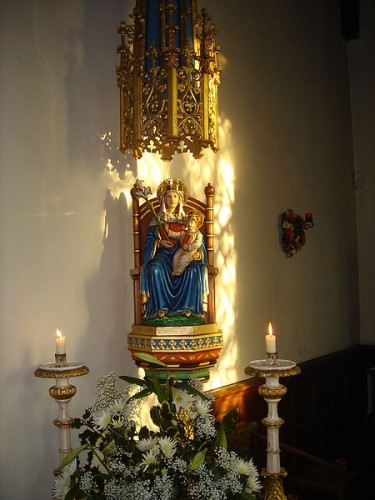 We have so much fun with the British press on GetReligion that it's wonderful to have the opportunity to flex some other critical muscles on behalf of our colleagues across the pond. Thanks to commenter David, who sent us this Times of London story about a new Catholic order of nuns, for giving me this opportunity. While there are some places where writer Joanna Moorehead doesn't go deep enough or give enough context, the vivid quotes and uncondescending portrayal of these unusual women compensate for her flaws.
The fact that it was written for the "Women's" section may go some way to explain some of the "gee-whiz" style of this article about the formation of the Community of Our Lady of Walsingham. The article begins with a multi-faceted portrait of a young woman, stewardess Katie Colbran, on the cusp of leaving her job to test out her call as a nun.
We have so much fun with the British press on GetReligion that it's wonderful to have the opportunity to flex some other critical muscles on behalf of our colleagues across the pond. Thanks to commenter David, who sent us this Times of London story about a new Catholic order of nuns, for giving me this opportunity. While there are some places where writer Joanna Moorehead doesn't go deep enough or give enough context, the vivid quotes and uncondescending portrayal of these unusual women compensate for her flaws.
The fact that it was written for the "Women's" section may go some way to explain some of the "gee-whiz" style of this article about the formation of the Community of Our Lady of Walsingham. The article begins with a multi-faceted portrait of a young woman, stewardess Katie Colbran, on the cusp of leaving her job to test out her call as a nun.
From September, she'll be Sister Katie: instead of the fast-moving, hard-living, sexy, dizzy, international world of air travel, she'll be surrounded by the peace, tranquillity and well-tended gardens of the community's House of Prayer. Instead of the Arrivals and Departures boards at Heathrow, her life will be ruled by the ancient rhythm that's been followed through the centuries by Catholic men and women who have taken up life as a monk or a nun: morning prayer, Mass, the Angelus, Vespers, night prayer. Instead of her mobile phone, she'll live by the bells of a religious house; instead of eating in a different restaurant in a different European city each night of the week, she'll be sharing meals around the simple community table with her fellow sisters. And instead of looking ahead to a future that might have included a partner and children, she'll be choosing a life in which a lover, and babies, can have no part.
In Western Europe in 2009, the life of a Roman Catholic nun seems bizarre -- all very well as the subject for, say, the comedy Sister Act (which has just been turned into a West End musical), but nothing to do with anyone's real life. And what's equally extraordinary is that the community Colbran is joining is, in these days of dwindling interest in religious worship in general, and in being a nun or monk in particular, almost brand new.
Some caveats -- Actually, nuns can take care of babies, and some do -- they just can't have them (unless they were previously married, but that's another story). Although apparently the number of vocations to the religious life in Great Britain are small, many religious orders have long been globally connected, and there are many places in the world where vocations are actually growing, as noted in this earlier piece on the order.
It would also help if the article gave some background on Our Lady of Walsingham. (My former rector, an Anglo-Catholic, made a retreat at the shrine, a favorite with Catholics and "spikey" Anglicans alike.)
Even if the essay sometimes read like a crash course on "nuns 101" the writer has some wonderful quotes from Colbran and from foundress Sister Camilla. Here's one in which Sister Camilla grapples with what it means to have walked away from the opportunity to marry and have children:
Giving up the chance of children, though, was a harder choice. "In your twenties, you don't really grasp what that's going to mean. And then in your mid-thirties it can be a lot more painful -- but it's part of the sacrifice, and you have to hold firm to what you are doing and to struggle on through, just as you do in a marriage when the going gets tough. All choices involve sacrifices of one sort or another."
Ain't that the truth.
The quote illustrates very well the tension between realism and idealism that infuses this piece -- voiced by the women Moorehead interviewed as they make what is indeed an unusual choice in a mostly secular British culture. This is a rare opportunity to see a religious community in formation (the Vatican has approved turning it into one that welcomes men, which likely is a whole other story in itself). There's a little gauze here, but there's more meat than one would expect in the lifestyle section -- and a potentially exciting story that really has only just begun to be told.
Picture of Our Lady Of Walsingham is from Wikimedia Commons
